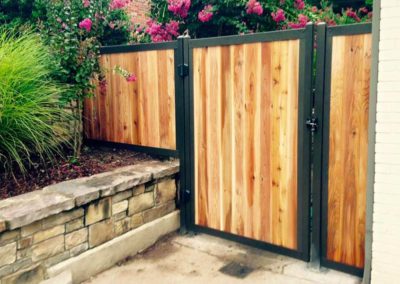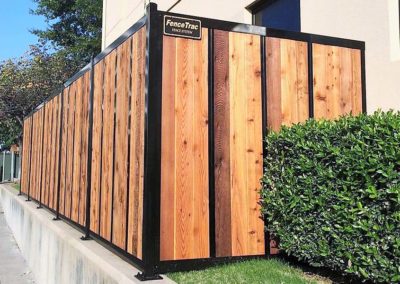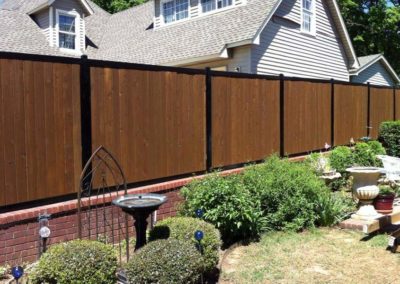How to Build a Retaining Wall Fence (A Complete Guide)
If you need to build a fence on top of a retaining wall…
 You understand that this can present a few challenges.
You understand that this can present a few challenges.
Just like there are different types of retaining walls.
There are different methods for mounting a retaining wall fence.
We’re going to explore a few options.
And look at a few retaining wall fence ideas.
IMPORTANT: this article describes fences that are used in conjunction with retaining walls. We do not recommend using the fence itself as the retaining wall.
Now, let’s start with the basics.
What is a Retaining Wall?
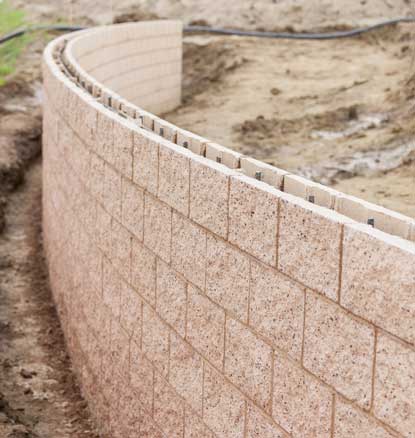 A retaining wall is a barrier designed to hold soil in its place behind the wall. Used to stabilize soil and prevent erosion, a retaining wall can be created from several different types of materials, including poured concrete, treated timbers, stacked blocks, bricks, rocks or other materials used to create a rigid structure that holds an area of soil together.
A retaining wall is a barrier designed to hold soil in its place behind the wall. Used to stabilize soil and prevent erosion, a retaining wall can be created from several different types of materials, including poured concrete, treated timbers, stacked blocks, bricks, rocks or other materials used to create a rigid structure that holds an area of soil together.
Think of it as a dam for dirt.
Retaining walls are built where you need to “retain” an area of soil that is at a higher elevation than the protected area below.
Sometimes after building a retaining wall.
Property owners need to build a fence on top of the wall as a safety or security measure.
Why You Might Need a Retaining Wall Fence
There can be numerous reasons you may want to mount a fence on top of your retaining wall.
Keep in mind.
That the ground level above a retaining wall and the ground level below the wall are at different elevations.
Safety Above The Wall
Retaining walls can be tall.
Perhaps behind your wall sits a part your yard, a walkway or a seating area at a restaurant.
If that’s the case, you will want a fence to prevent people or pets from tumbling over.
In fact, International Building Code 1015.2 requires guards (a fence) on any retaining wall over 30″ tall.
Installing a fence on top of the retaining wall can help provide a safe area above the fence.
Privacy For Your Property
Mounting a privacy fence on top of a retaining wall can be a fantastic way to get an extra measure of privacy.
Especially if you install a tall fence on the wall.
With that arrangement.
You will be able to keep prying eyes out.
Added Security
Some retaining walls are relatively low.
They could be easy to scale.
In that case, you may want a retaining wall fence to act as a barrier for your property.
Your fence provide security.
A Unique Wall Fence
Maybe you’re wanting to install a fence on top of the retaining wall for a different look.
You could pour concrete higher than you need it above the retaining wall to create a fall barrier.
But you’d prefer to have a fence instead.
Adding a fence can allow for an extra pop of color, while still providing you with safety and privacy.
Keep in mind that any retaining wall fence solution you might be considering should be run by an engineer to ensure the ongoing integrity of the wall itself after installation of the fence.
A Better Way to Design Your Retaining Wall Fence
Before looking at mounting options.
Let’s look at some fence options.
By design.
The FenceTrac fence system offers unlimited fence design possibilities.
Our patented fence panel system includes a U-shaped framework into which infill materials can be placed.

Side channels bolt to each post with self-tapping screws.
Then.
The infill material easily slides into the U-shaped FenceTrac fence panel frame that sits between each post.
The top and bottom channels attach to the side channels to hold everything together.
Each four-piece panel assembles with just four bolts.
Easy.

FenceTrac accommodates infill materials of up to 1-inch thick.
Design your fence with vertical or horizontal slats.
We offer cedar wood and PVC infill options shipped with your kit, but some property owners supply their own infill as well.
You can even build a hog wire fence with FenceTrac.
Using the Fencetrac system, fences can be design with a variety of materials such as:
- Western red cedar
- Eastern red cedar
- Cypress boards
- Treated pine
- Ipe boards
- Wood pallets
- Barn wood
- Vinyl planks
- Composite planks
- PVC planks
- Hardie board
- Metal screen
- Wood rails
- Black slats
- White slats
- Metal sheets
- Metal panels
- Perforated metal
- Etched metal
- Lattice panels
- Wood & iron
- Welded wire
- Cattle panels
- Reclaimed wood
- Corrugated metal
- Ribbed metal
- Stone veneer panels
- Brick veneer panels
- Bamboo
- Wrought iron
Now let’s take a look at some fences built with FenceTrac.
Surface Mounted Fence Posts on Top of Wall
If you have an existing poured concrete retaining wall.
Then you may be able to anchor the fence posts directly to the concrete.
Fencetrac fence posts are optionally available with metal base plates.
The top surface of your wall should be at least 12-inches wide to accommodate surface-mount fence posts.

These plates will have typically four holes drilled into them, where you install the anchor bolts.
In this case.
You would mark the holes and use a hammer drill to drill out the concrete prior to bolt installation.
This will give your fence a solid attachment to your retaining wall.
Face Mounted Fence Posts on Side of Wall
If you don’t want to mount the fence on top of the retaining wall.
Another idea is to attach fence posts to the side of your retaining wall.
Here’s an example.

Posts can fabricated with side mounting plates.
Allowing you the ability to drill and anchor the posts directly to the side of your wall.
This might be a great solution for your property.
Embedded Fence Posts in Poured Concrete Wall
If you are able to set the posts during construction of a poured concrete wall.
You can pour concrete around the posts.
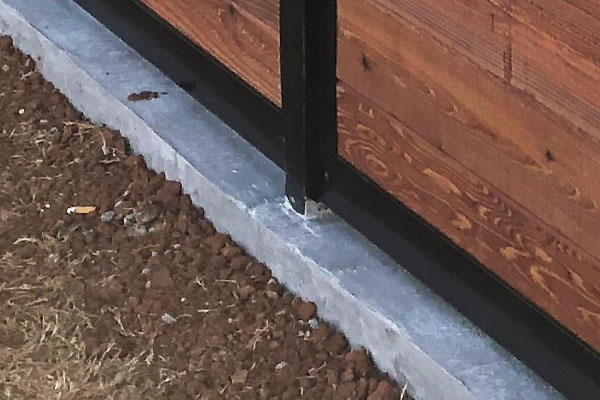
This creates a very ridid mounting solution for your retaining wall fence.
In fact.
It’s the strongest possible mounting arrangement.
The top surface of your wall should be at 10 to 12-inches wide to accommodate embedded fence posts.
Another alternative is to “core drill” your fence posts into the top of the concrete wall surface. The wall should be at least 12-inches wide.
As with any modifications to a retaining wall, you will want to consult local building codes and an engineer for design approval.
Segmented Retaining Wall Fence Post Systems
In addition to surface mount options.
There are a few other ways to install a fence system without compromising the integrity of your retaining wall.
Some retaining walls are made with dry, mortarless blocks.
While others use loosely stacked boulders or flat rocks.
These segmented retaining wall systems (SRW) may not be able to handle the load from a fence installed directly to the wall.
The Sleeve-it System
To fix this issue Strata developed the Sleeve-it system.

Courtesy of STRATA
The Sleeve-it system provides a method for installing the fence much closer to the wall.
Using a cantilever design, each Sleeve-it unit is designed to receive a fence post.
Allowing you to mount each fence post next to the retaining wall.
These anchor units allow the post to be slipped directly into the unit.
Then they are filled with concrete before backfilling of the wall occurs.
They also shift any fence weight and loads away from the wall directly into the ground.
If however.
Your retaining wall requires the fence posts to be installed directly into the wall.
You might want to look at the post-in system.
The Post-in System
This system integrated directly into the large hollow cores of a segmented retaining wall.

Courtesy of CornerStone Wall Solutions
Using a cantilevered anchoring slab of concrete that gets embedded underground behind the wall.
The system creates a counterweight to any horizontal loads applied to the fence.
This system allows for the maximum amount of land to be used on your property.
Reducing the gap between the fence and retaining wall.
Getting rid of the need to maintain any grass between the fence and the wall.
In Conclusion
If you need to build a retaining wall fence.
You’ve got several options in terms of design of the fence itself and mounting arrangments for posts.
We highly recommend metal fence posts for your wood fence, as these will not rot.
Also, you don’t want to need to replace the fence anytime soon.
Because the cost involved in installation can be much higher than installing a fence in your yard, for example.
If you’re interested in the FenceTrac system, request an Instant Quote online.





